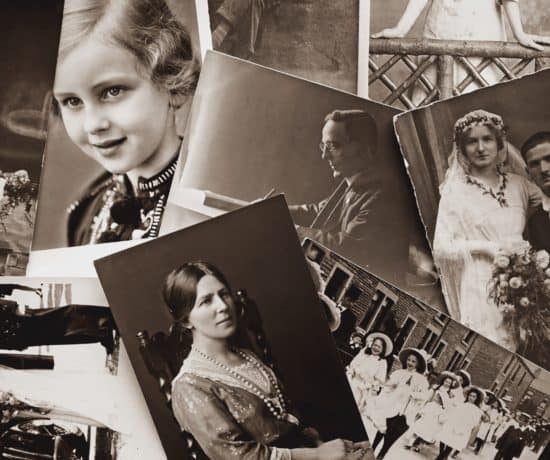We all make mistakes. It’s part of life, right? But those of you who know me personally can vouch for just how much I hate messing up. It’s not just that I’m a perfectionist (OK, maybe a bit), but it’s also the fact that most mistakes are entirely preventable. That’s why I’ve come up with this list of the top 12 mistakes people make with their photos. Some are easy fixes, and some require a bit more work, but they are all worth rectifying. Your photos are just too valuable for you to make mistakes with them, so this is a heads up for those of you who are just in the beginning stages of learning about photo organizing and preservation. Be smart and shorten your learning curve by learning from other people (including me) because, yep, we’ve all been there. We’ve all made that mistake.
Mistake #1 – You’re Not Preserving the Story behind the Photo
[Printed + Digital]
The number #1 mistake people make with their photos, regardless of whether the are printed or digital, is that they forget to write down the story. And what is a photo without a story? In my work, I come across unidentified photos all the time. A memory that was important to someone, somewhere, yet there are no names, no dates, no details recorded. Don’t make this mistake with your family’s photo library! Does it take time? Yes, but it’s absolutely worth it!
If you have printed photos, I encourage you to do something with them. Perhaps you could create a scrapbook to remember the occasion? For printed photos, you can also write the most important details on the back of the photo (using archival pens, of course), or create an album that has an index – anything to prevent the story from getting lost! If you have digital photos, add your stories to the descriptions of your photos (the metadata) and create photo books to highlight the best moments each year.
There’s nothing more frustrating as a photo organizer than finding beautiful photos with no clue who is in them or where they were taken, and that’s why I’m so passionate about my job! You’re taking photos to capture a moment forever, and to be able to remember and share that moment later on, so don’t forget the storytelling part! We want to know who, what, when, where, and why!
Mistake #2 – You’re Storing Your Photos Incorrectly
[Printed]
Photos, especially older prints, need to be stored correctly to last, and yet the majority of collections I’ve come across have been stored in dusty boxes far too close to hazards like water and mold. Don’t make this mistake with your photos! You don’t want a yellowed, smelly, damp family history, do you?
Nope, in order to keep your photos safe, you need to store them correctly. Keep them at a stable room-temperature – not too cold and not too warm. Try to keep them in a dry environment with less humidity. Keep them away from children and pets unless there’s adult supervision. Purchase good quality archival storage supplies that won’t damage your photos, and get them out of those magnetic albums! A little bit of investment in good quality storage goes a long way towards keeping your legacy protected!
Mistake #3 – You Don’t Have a Digital Photo Hub (DPH)
[Digital]
Wanna stay organized? Then get yourself a reliable DPH – digital photo hub!
This ties right back into mistake #2 as it’s the technological version of improper storage. Remember how I explained that you need good, archival quality storage for your printed photos? Well, your digital photos aren’t that different. They need good quality storage too – just in a different format. A digital photo hub is the one place where all your photos can live safely together, and it’s the secret weapon in your organizational arsenal. Every photo you take goes there, and every photo you share (or use for a project) comes out of there.
The foundation of good organizing is to keep like with like instead of having everything scattered about, so why should your photos be any different? Nope, they don’t get a pass. They need to be collected in one central (and safe) location, so that you know where to look for them! If you don’t know how to set up a digital photo hub, I have a blog post right here that will help you pick a good one. If there’s one thing you spend money on, make it this! Create a digital museum for your masterpieces, so you can keep them organized and backed up instead of having them scattered on different devices!
Mistake #4 – You Don’t Have a Clear Backup Strategy
[Printed + Digital]
What if your computer crashes tomorrow? What if your home floods next week? Do you have a clear backup strategy for your photo collection? Unfortunately, not many people do. Don’t make this mistake with your photos! There are far too many hazards out there, like natural disasters, tech crashes, and household (read phone-in-the-toilet) bloopers that can derail your plans for the perfect photo legacy. Having a clear backup strategy combats this problem because you’ll be prepared, and instead of losing everything, you will drastically minimize the loss.
You can create your own clear backup strategy in less than an hour by defining a few important details, like how your digital photo hub (DPH) and your printed photos are backed up, and where. My Backup Basics blog series shows you step-by-step how to write a plan, but if you’d rather not create your own, you can also use the 3-2-1 method, which is the official recommended way to back up your photos. A strategy already made? Yes, please!
Remember that your strategy doesn’t have to be perfect, but it does have to be implemented. Do it while you have the chance.
Mistake #5 -You’re Not Transferring Your Photos To Your DPH Consistently
[Digital]
Perhaps you have a digital photo hub, but you’re not using it much? Maybe your photos aren’t transferred as often as they should? If you find yourself in this situation, it’s usually a product of one of these two possible scenarios: 1) your DPH is inconvenient, or 2) you’re not scheduling maintenance time.
For problem #1, figure out why your DPH isn’t working for you. Is it too time-consuming to transfer photos? You probably need a better workflow. Think about how you can make your life easier… Where do the majority of your photos originate from? How can you get them to your DPH with as little work as possible? Troubleshoot and fix that problem before you have a huge backlog to organize.
If you find that time is an issue, it’s even more imperative that you put organizing on your calendar. When you take the time to schedule regular maintenance for your photos (or anything in life, really), it saves you a whole lotta time later on. In short, things don’t pile up on you. When you make an appointment with yourself to transfer your photos off your iPhone, you actually create room for new memories to come into your life instead of feeling guilty that you haven’t dealt with the old ones, so create a default strategy for how to handle your photos, and watch your productivity soar!
Mistake #6 – Your Photo Organizing Program Can’t Handle Metadata Correctly
[Digital]
For the sake of easy explanations, let’s just say that some photo organizing programs aren’t as nice to your photos as they should be. They let you enter a bunch of information, but then they don’t keep that information together with the photos. This becomes a problem if you decide to change computers, move your photos, or if the version of the program you’re using becomes obsolete. Imagine having spent hours and hours typing stories into the metadata of your photos, only to have that information vanish! Not fun. To combat this problem, you need to use a photo organizing program that’s capable of handling your metadata correctly. In a nutshell, it needs to keep the photo and the information you enter about that photo together.
I recommend working with an independent folder structure (that means a folder structure that doesn’t need a specific software, and that can move freely between different programs). In most cases, that means your photo organizing program will be referencing your files instead of copying them. Mylio and Adobe Lightroom really does it the best, but with a few adjustments, Photos for Mac works too! When selecting a photo organizing program, take the time to check how it will handle your metadata (your stories!) before you put in hours of work!

I’m a Perfect Pinnable!
Mistake #7 – You’re Not Renaming Your Files
[Digital]
What does the name DSC_1208.jpg mean to you? My guess is… not much.
When you organize your digital photos, the best thing you can do is rename your files. In fact, I’d say it’s the single most important step you can take next to telling the story. In theory, every file on your computer should reference something that is recognizable and understandable to you, but yeah, I can understand if that doesn’t aways happen. We download so much digital clutter every day that it would be almost impossible to sit there and rename everything. But your photos are different. Your photos are files you plan on saving for a long time; they’re not just files that you’re working on temporarily. You see, there’s a difference between files that hold little value and files that hold tremendous value, and I’m sure you agree that your photos would fall into the latter category.
To best protect your photos, you have to archive them properly and label them so that you don’t have to rely on your memory for identification. You have to pick a name that triggers a memory for you, so think about how you naturally remember things. Do you remember dates? People? Events? When you are organizing your photos, you want to pick a sorting style, and then be consistent with that pattern. When you rename your files in a pattern, it not only keeps everything organized, but it let’s you see what you have at a quick glance, so you’ll be more likely to look at your photos and enjoy them.
Mistake #8 – You’re Scanning Your Photos at the Wrong Quality
[Printed]
Scanning your photos, are ya? That’s great! Scanning your prints is the best way to ensure that they’re preserved for the future, but here’s a question for you: what quality are you scanning them at? If you’re going to invest time and money into scanning your photos, don’t you want to scan them at a good enough quality? After all, why put in all that effort if all you can do is watch them on a screen? Don’t have a “whoops, too late” moment that forces you to start all over again! When it comes to quality, the two most important things to look for are: file format, and resolution.
Format
The best archival-quality file format is the TIFF file, so if you really want to create a high-end family history, you’ll want to scan TIFFs. You can get by with JPEGs too, but you need to understand the difference, so you can make the correct choice. Most companies will scan your photos as JPEGs without even asking for your input, so if you’re outsourcing, ask! You’ll want to hire someone who knows the difference between the two formats, and who can give you the option.
Resolution
Resolution is even more important. With a low resolution, your photos will look pixellated. In my opinion, you should not be scanning your photos at anything less than standard print resolution, which is 300 dpi. Even better? 600 dpi. To be able to do that, you will have to invest in a scanner rather than using a smartphone app. There are many apps on the market that can scan your photos, but as I explained in this blog post, the quality is lacking. It’s not the app’s fault by any means – phones just aren’t good enough yet. Maybe in the future they will be, but until then, invest in a better scanner, or hire a Personal Photo Organizer. It’s worth the extra change.
Mistake #9 – You’re Not Editing Your Photo Collection Down to Size
[Printed + Digital]
Photo hoarding is real. In fact, it’s very common. Digital photography has become so easy that most people have 3-5 versions of the same photo. If you find yourself using the burst feature more than once a week, there just might be a chance you have duplicates. You don’t need them all. It takes up far too much space, and it’s far too time-consuming to organize all of them. What you need is to occasionally delete shots, especially those that are blurry, bad, or just taken at really bad angles. I’m guilty of this too. I’m more of a keeper than a tosser, so I have to make a conscious decision to go through and delete photos on a regular basis. It can be so easy to say “oh well, what’s the harm? I’m just gonna keep it!” when actually it doesn’t help. It detracts from your core collection, which is what really matters.
To fix this problem, schedule monthly photo organizing time where you can sit down, compare shots, and get rid of the ones that you don’t need. There are many photo organizing programs (Lightroom, Mylio, etc.) that will let you pull up two photos next to each other to compare. You want to keep the ones that tell the story the best. You’ll want to define some criteria that you can check off to decide if a photo stays or goes. My criteria is that is has to be a good angle, in focus, and tell the story of that moment better than any other photo. Define your own criteria, and put it to good use.
Your core collection is what matters. It’s free of clutter. It’s free of poorly-lit portraits, selfies gone wrong, and duplicates. Keep the best, delete the rest.
Mistake #10 – You’re Completely Ignoring Your Digital Rights
[Digital]
Okay, okay, I hear ya! Legalese is boring. And scary. And why bother? But hear me out for a second.
My mom always told me to read contracts before signing them to make sure what I was getting into, and I’m glad that she did because it has helped me a lot in life. Have I always done it? Of course, not! I’m not a robot. But I do try to at least glance at them to look for a few specifics that I know are important. You need to find your own bullet point specifics that matter to you, so that you can get through contracts in as little time as possible. The language may be intimidating, but don’t let that stop you from understanding what they really want. It’s about looking out for yourself.
When it comes to your photos, the same idea applies. You need to look out for them. I’d like you to read this blog post that I wrote a while back. It showcases why some of the free services aren’t necessarily what’s best for your photo collection. Remember that these are for-profit corporations, not charities. They’re not just going to give you a great service for free without asking for something in return. We all love Google, Amazon, and Flickr. Honestly, I probably don’t go a day without using either of them, but I don’t trust them with my photos. Some services are nicer than others, but you can make up your own mind.
I’m not here to tell you that you can’t use any free services. Of course, you can! I just want you to pay attention, so you know what you’re getting into, and what you’re giving up. Don’t ignore your digital rights!
Mistake #11 – Your Haven’t Designated An Account Manager for Your Photos
[Printed + Digital]
Most families have one designated family historian – the person who takes care of the collective memories of the family. I’m that person in my family, and chances are (since you’re reading this) that you’re that person in your family. You probably have it all under control. You clearly care about your memories. It’s probably all organized, and backed up. Kudos to you if that’s the case! But what happens in case of a tragedy? What if something happens to you? Who’s next in line to care your family legacy, and does that person have access to your photos? Would that person know what to do?
We’d all like to think that nothing bad will ever happen to us, or any person we love, and while I agree that it can be a bit morbid to think about this, planning ahead is never wrong. Don’t be afraid to create a plan where your family history is a part of your legacy. If you’ve done the work of organizing, scanning, and preserving your family photos, you want to also make sure that future generations will enjoy them too! That’s what it’s all about, after all. It shouldn’t fall apart without you. I’ve created backup strategies for lots of clients, and I’ve even had clients who worked their family photo collections into their wills & estate planning. You can do that too. You need to pick a trusted person as your account manager, and that person needs a clear plan of action to follow in case of emergency.
A good example is Forever.com, which is my favorite cloud storage. They not only let you designate account managers, but they also let you customize a succession plan for your family, which ensures that your photos will always be in good hands.
Mistake #12 – You’re Not Creating Anything with Your Photos
[Printed + Digital]
Photos are meant to be shared and enjoyed, don’t you agree?
And yet, we’re not creating enough with our photos. Why? Because of the sheer volume. They’re scattered everywhere, and there’s just too many of them. But…if you remedy the rest of the mistakes you’re making with your photos, you’ll find that creating something will be much easier. If you can find all the photos you took at spring break, you can make that photo book. When you’ve gotten rid of all the bad shots, you’ll have a much easier time finding the good ones to share. And if you’re scanned your prints at a good resolution, you’ll be able to create gifts for your family.
I understand that it’s hard to find time to create stuff with your photos, especially since organizing them is a big job in itself, but remember that there are people who do this for a living – like me. I have hundreds of colleagues around the globe at the Association of Personal Photo Organizers, and any one of us would be honored to help you with your photo legacy. In this digital age, no one is too far away!
When your photos are not in your life, you’re missing out. In a hectic and increasingly unstable world, you need to celebrate the good moments as much as possible, so bring those photos back into your life, and remember why you took them in the first place!





